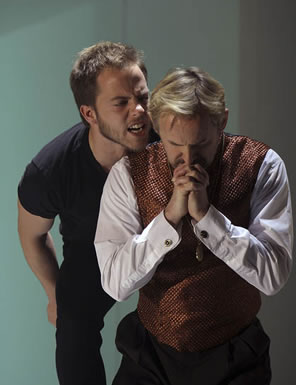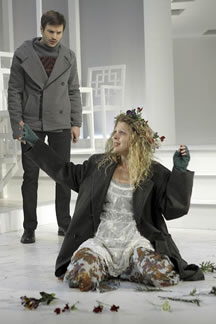Hamlet
On the Next Dr. Phil: The Hamlets
Folger Theatre, Washington, D.C.
Thursday, May 13, 2010, F–8&10 (center stalls)
Directed by Joseph Haj

Graham Michael Hamilton as Hamlet contemplates killing Claudius, played by David Whalen. Below, Lindsay Wochley as a mad Ophelia and Justin Adams as Laertes. Photos by Carol Pratt, Folger Shakespeare Library.
First impression is the most lasting one. Every time we walk into the Folger Theatre for a play, we gasp at the set. In this instance, we entered to James Kronzer’s modern living room of a palatial Danish home, tasteful but stark white, angular with a hallway extending back into the rest of the home. One of the Elizabethan Theatre stage pillars supported a loft overlooking the public area; the other pillar opened up into a tri-mirrored vanity in Gertrude’s closet.
Thematically, this setting offered Hamlet up as a domestic tragedy, one where the interpersonal relationships of individuals unable to peer beyond their own all-consuming needs bring on the family’s apocalypse. You sense that if only Dr. Phil had gathered this clan for a bit of group soul-sounding, perhaps they’d get past their hang-ups and at least come to tolerate and respect each other (or, for heaven’s sake, just let Hamlet go back to Wittenburg). But, then, the individuals in this family are too self-absorbed to benefit from counseling.
You have Hamlet stubbornly gripping his emotional demons. Indeed, as played by Graham Michael Hamilton, he thrived on having such demons. His Hamlet is the original angry young man finding fault and fraught in any and everything, a Renaissance Perez Hilton who today would log on to blogs and type out all-cap diatribes.
You have Gertrude, played by Deborah Hazlett as the gracious wife of a politician, with a Saks Fifth Avenue wardrobe and a patient smile for others who irritate her. She clung to her pleasant existence, one in which she could live in luxury, enjoy a doting husband, and not be troubled with a pouting son. When she claimed the Player Queen doth protest too much, she was not commenting on her own guilt so much as posturing that creature comforts and security take priority over loyalty and true love.
 You have Ophelia, with Lindsey Wochley looking very much like Taylor Swift, preferring to get by with a minimum amount of smarts and therefore too gullible to the desires of others and too naïve to understand interpersonal dynamics.
You have Ophelia, with Lindsey Wochley looking very much like Taylor Swift, preferring to get by with a minimum amount of smarts and therefore too gullible to the desires of others and too naïve to understand interpersonal dynamics.
Then you have Claudius who is, well, just plain too guilty. Aye, there’s the rub. I can’t recall seeing a Hamlet where the constant, underlying current of the original sin—Claudius murdered his brother—was so prominent. Key to this was the Mousetrap’s staging, where the players were presented only in recorded voice coming from the back of the theater while the court audience, lighting effects flickering over them, faced the theater audience. Not only did we see Claudius’ reaction to the murder, we saw Gertrude’s non-reaction. She didn’t even react to the Player Queen’s protestations while Claudius grew increasingly uncomfortable, fearing that Hamlet’s intent with the play was to embarrass Gertrude (“Is there no offence in’t?” he asked well before the murder scene is carried out, as this production dropped the dumbshow). Sure, he got the crown, but David Whalen’s Claudius, above all else, was driven by his love for Gertrude, especially as they apparently were already involved romantically before the murder. This Hamlet thus becomes a cautionary tale about extramarital affairs, albeit one ending in carnage for more than just the guilty couple.
The innocent victims caught up in all this sin and self-absorption were Polonius, Rosencrantz, and Guildenstern, three guys with good intentions blindsided by the court intrigue and passions. That Polonius, Rosencrantz, and Guildenstern should emerge as “innocent victims” would seem to mean textual cutting and shifting. Actually, no. Lines and scenes were cut for the purposes of brevity, and the only scene instructive to Polonius’ behavior that was missing was his instructions to Reynaldo about spying on Laertes. More important than cutting lines, though, was director Joseph Haj’s instruction to his actors to strip away all conventions and traditions and draw their motivations solely out of the text.
Stephen Patrick Martin found in Polonius a widowed father of two grown (but dependent) children and a counselor for the new king, a holdover from the previous administration trying to make sure he remained relevant. He was always aware that the new boss could question his loyalty and cease his employment (in this context, even the Reynaldo scene would play as a father making sure his son’s actions didn’t lead to a career-ending scandal, which would make perfect sense to a D.C. audience).
Meanwhile, rather than being Tweedles Dee and Dum, Rosencrantz and Guildenstern were two different people with two different intents: Dan Crane’s Guildenstern shifted toward serving the king above all else, while Billy Finn’s Rosencrantz continued soliciting Hamlet’s friendship until the prince finally cut him off in the pipe scene. If your supposed friend suddenly pulled rank on you, then you might as well shift your loyalty to the higher-ranking individual. Neither Rosencrantz nor Guildenstern purposefully indulged in the court intrigue. And why should they? They were invited by the parents to help their friend find some joy in life again, but they find that friend doing some weird stuff, turning obnoxiously rude, taking on a ’tude, and then killing a perfectly nice man. Why wouldn’t they agree to escort their friend to England where he couldn’t harm anybody else in Denmark and might even get some help? They don’t know what’s in that letter to the English king.
Haj did introduce two bits of surprising business to this play, one legitimate, the other not, but both effective. First, Ophelia revealed her pregnancy in the mad scene. This underscored the anguish in the nunnery scene on the part of both Ophelia and Hamlet, it helped explain Ophelia’s tripping into insanity when her lover kills her father, and it lent more credence to Hamlet’s passion in the graveyard scene. In a post-show discussion, the dramaturg, Michele Osherow, said the textual clue for this staging is found in the herbs Ophelia gathers, which are part of a medieval miscarriage-inducing recipe. Haj’s more dubious interpolation of the text was having the Ghost re-appear in the last scene and catch Hamlet as he fell. Todd Scofield played the ghost with both majesty and affection for his son, and when the prince died in the arms of his father, Scofield’s ghost gazed out at the audience with the beatific look of a man who not only had been revenged on his murdering brother and adulterous wife but also had his doting son with him once again. This piece of business was actually added during the production’s previews, and in the post-show discussion, Hamilton called it “poetic.” It certainly was that.
Eric Minton
May 15, 2010
Comment: e-mail editorial@shakespeareances.com
Start a discussion in the Bardroom



 Find additional Shakespeareances
Find additional Shakespeareances